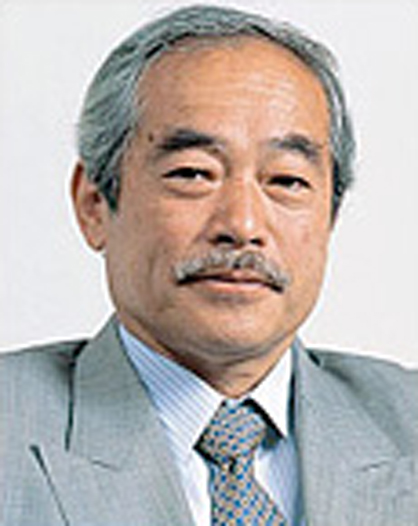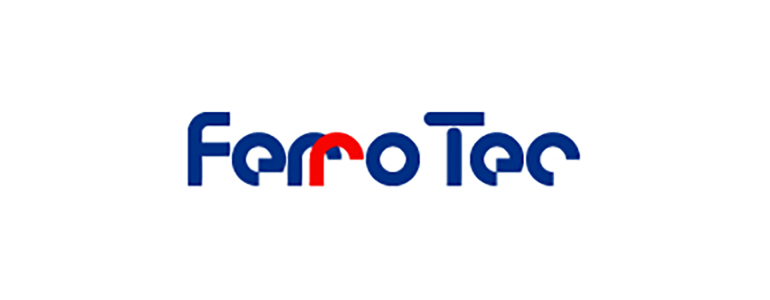| Ferrotec Corporation (6890) |
|
||||||||
Company |
Ferrotec Corporation |
||
Code No. |
6890 |
||
Exchange |
JASDAQ |
||
Industry |
Electric Equipment (Manufacturing) |
||
President |
Akira Yamamura |
||
HQ Address |
Nihonbashi Plaza Building, Nihonbashi 2-3-4, Chuo-ku, Tokyo |
||
Year-end |
March |
||
URL |
|||
* Share price as of closing on December 14, 2016. Number of shares issued at the end of the most recent quarter excluding treasury shares.
|
||||||||||||||||||||||||
|
|
* Estimates are those of the Company. From the FY3/16, the definition for net income has been changed to net income attributable to parent company shareholders (Abbreviated as parent net income).
|
| Key Points |
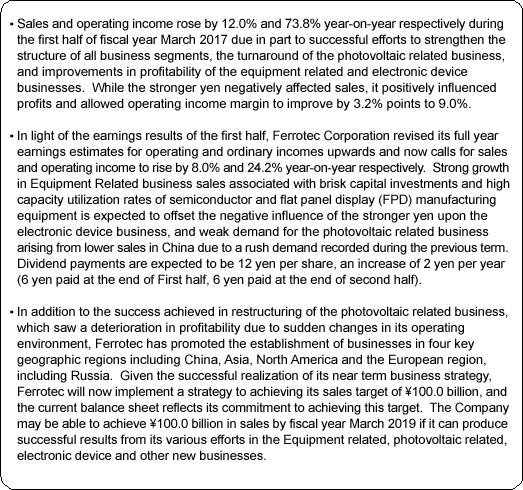 |
| Company Overview |
|
<Corporate Philosophy and Code of Conduct>
Corporate Philosophy
Bringing Satisfaction to Customers
Caring About the Environment Providing Dreams and Vitality to the World Ferrotec Group's goal is to offer high quality products and services primarily in the realms of "new energy" and "electronics", and gain the trust and satisfaction of customers through the provision of price competitive products and services. Ferrotec Group will proactively promote global eco-friendly activities as one of our important management tasks and without delay comply with the latest environmental regulations. In addition, we seek to develop material, products, etc. that can be utilized in "new energy" applications and as part of our efforts to resolve various problems confronting the global environment. Ferrotec Group seeks to contribute to society by leveraging our core technologies and to be a company that continuously satisfies the expectations of our customers, stockholders, employees, clients, communities, and other stakeholders. Furthermore, all of our activities will be conducted to remain in strict compliance with laws, ordinances, social orders, international rules and social common sense. <Business Segments>
Ferrotec's operations can be divided into three segments: 1) The Equipment Related Business Segment, where vacuum feedthroughs, quartz products, ceramic products, etc. used in semiconductor, FPD, and LED related manufacturing equipment are manufactured, 2) The electronic device business segment, where thermoelectric module application products are mainly made, and 3) The photovoltaic related business segment, where silicon crystal, PV wafers, and crucibles used in crystal manufacturing devices are produced. In fiscal year March 2016, sales of the production device, electronic device, and photovoltaic business segments accounted for 45.2%, 19.2% and 26.6% of total sales respectively, while saw blades, equipment parts cleaning, machine tools, and other business segment (non-reported segment) accounted for 9.0%.
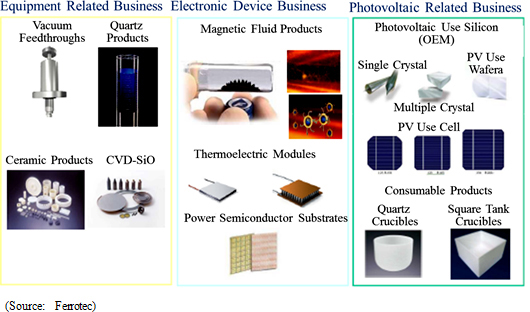 Equipment Related Business
Ferrotec provides total engineering services in the equipment related business segment, including the manufacture and sale of vacuum feedthroughs of equipment parts for solar power, semiconductor, FPD and LED applications, consumable products used in manufacturing, quartz products, ceramic products, CVD-SiC products, silicon wafer processing and equipment cleaning services (50% share in China).The main product of vacuum feedthroughs boasts of top market share in the world, and is a functional part that insulates the interior of manufacturing equipment from gas and dust contamination while supporting rotating action of the above mentioned equipment. These vacuum feedthroughs use magnetic fluids (Fluids that respond to magnetic fields), which has been a core technology of Ferrotec since its founding. Because of instability in these applications arising from their link with corporate capital investments cycles, the Company focuses its marketing efforts upon expanding sales to applications for which demand is more stable, including transportation equipment, precision robots, and general industry usages. In addition, Ferrotec has also focused its efforts upon assuming consigned manufacture of vacuum chambers that use vacuum feedthroughs and gate valves (Both use vacuum related equipment). At the same time, quartz, ceramic, and CVD-SiC products are critical elements in the process of semiconductor manufacturing. Quartz products are able to resist high temperature conditions that exist in the semiconductor manufacturing process, and are a high purity silica glass product that protects semiconductors from undergoing chemical reaction by preventing it from activating with gas. Ferrotec boasts of a high share of quartz crucibles (Photovoltaic related business) used in the photovoltaic cell manufacturing process. This technology is also being used to cultivate high purity crucibles for use in semiconductor applications. The Company boasts of semiconductor manufacturing equipment manufacturers as their main clients in Japan and overseas who purchase ceramic products, which are Ferrotec's core material and machining technology. At the same time, semiconductor inspection tools for machinable ceramics and fine ceramics used in semiconductor manufacturing equipment are two main products in this realm. CVD-SiC (*) products are SiC products manufactured by chemical vapor deposition method, or "CVD method" (Chemical vapor is created with a mixture of silicon gas and carbon gas). Currently, semiconductor equipment and structural parts are provided, and research and development for products used in aeronautics and space (Turbine, mirrors), automobile (Power semiconductors), energy (Nuclear power related), information technology (Semiconductor manufacturing equipment parts) and other applications are also being conducted. In addition, Ferrotec has achieved an output of 300,000 units per month of 6 inch wafer processing (Ingot slicing) primarily for discrete semiconductor applications, and its contributions in the realm of small diameter wafer processing are becoming significant. Electronic Device Business
Thermal element "thermoelectric modules" are products that can instantly raise or lower temperatures to a highly precise degree and are core products of this business. Thermoelectric modules are used primarily in heated automobile seats, and also in a wide range of other applications including genetic analysis equipment, optical communications, and consumer electronics. Ferrotec is also devoting efforts to expanding the range of applications for this product by improving product quality, introducing automated manufacturing lines to reduce costs, and developing new high performance materials. Sales of magnetic fluids, including applications currently being developed for use in fishing reels (Water protecting internal seals) and speakers for 4K televisions, are also conducted in this segment.
Photovoltaic Related Business
Ferrotec entered the photovoltaic related business in 2005, and manufactures and sells silicon crystal manufacturing equipment, consumable products including quartz crucibles, and silicon products used in photovoltaic applications. Based on the current needs of the market, the Company is conducting manufacture and sales of single crystal crucibles manufactured when making ingots and silicon-use multiple crystal vessels (Both manufactured using quartz processing technologies), and consigned manufacturing of silicon crystal ingots and wafers used in photovoltaic substrates. Concerning consumable products like crucibles, Ferrotec boasts of a high market share due to its wide-ranging lineup of products and ability to manufacture customized products.
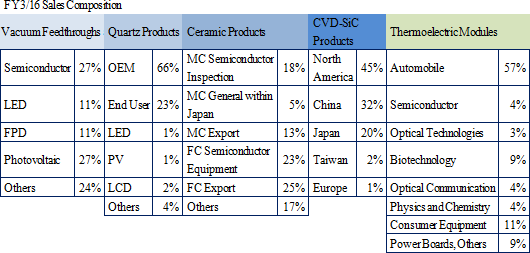 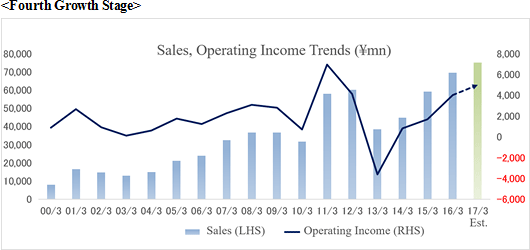 |
| First Half of Fiscal Year March 2017 Earnings Results |
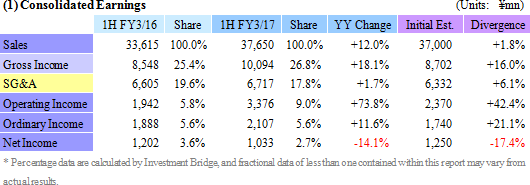 Operating Income rose 73.8% Year-On-Year On Strengthened Earnings Structure in All Businesses
Sales rose by 12.0% year-on-year to ¥37.650 billion. While sales of the electronic device business segment fell by 5.2% year-on-year due to the negative influence of the stronger yen, capital investments in India, China, and newly developing nations acted as a tailwind and allowed sales of the photovoltaic related business to grow by 21.8% year-on-year. At the same time, investments in semiconductor, and liquid crystal and OLED panel manufacturing facilities in overseas markets and high capacity utilization rates of manufacturing equipment contributed to a 3.6% year-on-year rise in sales of the Equipment Related business. Operating income rose by 73.8% year-on-year to ¥3.376 billion. The turning of the photovoltaic related business to profits and improvements in profitability of the equipment related business and electronic device business allowed cost of sales margin to fall by 1.4% points and gross income to rise by 18.1% year-on-year. At the same time, cost savings from effective optimization of operations, reductions in costs resulting from the strengthening of the yen and restraint in one off expenses allowed growth in sales general and administrative expenses to be limited to only a small margin from the previous term. Ferrotec was able to absorb foreign exchange translation loss of ¥1.122 billion arising from the stronger yen's influence upon yen based financial obligations of overseas subsidiaries and grow ordinary income by 11.6% year-on-year (Due to the December year end of subsidiaries, the accounts from the close as of June were used. The foreign exchange rate at the end of the first half rose by a large margin to ¥102.91 from ¥120.61 at the end of the previous first half.). Booking of ¥288 million in extraordinary loss associated with the liquidation of fixed assets of photovoltaic related business due to declines in capacity utilization rates caused net income to decline by 14.1% year-on-year. During the first half, foreign exchange rate averages of ¥111.80 to the United States dollar (Compared with ¥121.03 in the previous first half and initial estimates of ¥105.00), and ¥17.03 to the Chinese yuan (Compared with ¥19.19 in the previous first half and initial estimates of ¥16.50) were seen.
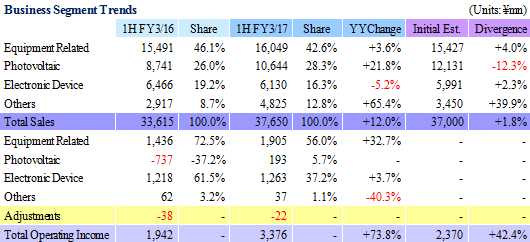 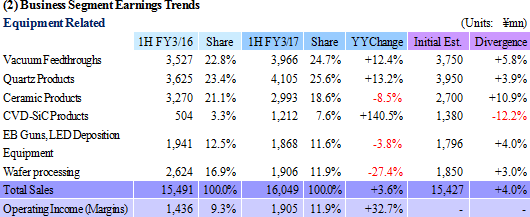 With regard to quartz products, all categories were able to see higher sales including OEM products sold to major United States and Japanese semiconductor manufacturers, and products sold directly to semiconductor end users in Japan, Taiwan, and China. While strengthening of the yen contributed to a decline in exports, ceramic products saw favorable trends on the back of strong demand for "photoveel" machinable ceramics and fine ceramics from both inside and outside of Japan. Sales of CVD-SiC products to major customers (Major equipment manufacturers in China, Untied States, and Japan) also rose, with new projects for OEM products from major Japanese equipment manufacturers being captured. Aside from these developments, Ferrotec has also been able to secure strong leads on potential business from applications outside of the semiconductor realm. However, the negative influence of the stronger yen caused actual results to fall shy of initial estimates. In addition, sales of EB guns used as heat sources for film formation equipment and LED deposition equipment used in vapor deposition of metallic films declined due to the negative influence of the stronger yen. However, compound semiconductors used in smartphones and communications chip applications trended strongly. Sales of wafers processing also declined due to the stronger yen, but demand for small diameter wafers (Six inch discrete wafers) remained strong in line with plans. Construction of a plant for eight inch wafers is expected to begin shortly.  In addition to higher capacity utilization rates, the completion of impairment accounting allowed operating income to turn to a profit from a loss. Ferrotec will continue to implement efforts to review products with low profitability and improve profitability.  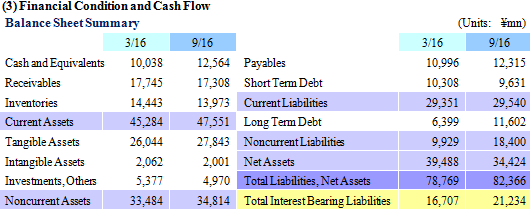  Asahi Seisakusho Co., Ltd. Converted to a Consolidated Subsidiary
Asahi Seisakusho Co., Ltd. was converted to a consolidated subsidiary on July 1, 2016 (2,042,394 shares acquired for ¥266 million for a 68.08% controlling share of total shares). Asahi Seisakusho boasts a history of over 83 years of business in industrial cleaning equipment realm and is the industry leader. Since its founding, it has firmly established its market leading position through its aggregation of technological expertise. Factors behind the acquisition of Asahi Seisakusho to become a consolidated subsidiary include 1) expansion in cleaning outsourcing services and 2) growing need for energy and resource conservation and automation of industrial cleaning related equipment in China and developing countries. Ferrotec expects the markets for cleaning outsourcing from hotels and other applications to expand given the growth anticipated in the service industries in China and developing nations. The Company also expects the need for automation and energy and resource conservation functions to expand, given the growing concern for environmental issues, energy conservation and cost efficiencies. Therefore, the acquisition of Asahi Seisakusho to become a consolidated subsidiary is designed to address these growing demands from China and newly developing countries and will be leveraged by the Shanghai Plant. This acquisition was also undertaken to expand Ferrotec's business realms beyond the general industrial applications and to pursue synergies within its group.
 |
| Fiscal Year March 2017 Earnings Estimates |
 Full Year Operating, Ordinary Incomes Revised Upwards on Back of Strong First Half Earnings Results, Profits to Rise to Second Highest Level since FY3/11
Strong investments in and high capacity utilization rates of semiconductor and flat panel display manufacturing equipment are expected to allow sales of the Equipment Related business to rise and absorb the negative influence of the stronger yen upon the electronics device business and lower sales due to a sudden surge in demand in China from the previous term in the photovoltaic related business. The equipment part cleaning service is also expected to grow. With regard to profits, operating income is expected to rise by 44.1% year-on-year in reflection of the strong growth of the first half and based upon conservative assumptions for estimates during the second half.Ferrotec's assumptions for average foreign exchange rates are ¥105.00 per United States dollar (¥121.03 during the previous term), and ¥16.50 per Chinese yuan (¥19.19 during the previous term). Capital investments, including the outstanding payments for facilities at the end of the previous term on a cash flow basis, and depreciation are expected to amount to ¥8.0 and ¥4.5 billion respectively (¥3.440 and ¥4.303 billion respectively in the previous term). Dividend payment is expected to be ¥6 per share at the end of the full fiscal year, and ¥12 on a full year basis after the payment at the end of the first half is considered.  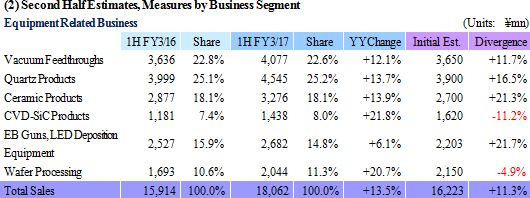 Both OEM applications and direct sales to end users in the semiconductor industry of quartz products are expected to grow. Demand for products on an OEM basis accompanying introduction of next generation equipment by major United States manufacturers (Full scale expansion in demand and strong growth in sales are expected to appear from the first half of fiscal year March 2018 onwards), and introduction of new equipment and next generation products by major Japanese manufacturers are expected to grow strongly. Sales of products directly to end users in the semiconductor industry are expected to continue to trend strongly on the back of high capacity utilization rates in Taiwan, China, and Japan. Ferrotec plans to expand investments in its manufacturing facilities in China and increase its staff numbers. With regard to ceramics products, sales of both machinable ceramic photoveel and fine ceramics are expected to grow. Ferrotec is conducting efforts to supply products that match the needs of automobile industry application logic inspection jigs, which are trending favorably, and miniature inspection jigs for next general smartphone applications of major overseas foundries. Furthermore, the Company is facilitating its manufacturing structure for cultivating demand for highly accurate products that respond to the needs of wafer circuit inspection jigs (Response to increased demand for memory inspection jigs that appeared within Japan from the latter part of the first half). At the same time, demand for fine ceramics is expected to grow as the yearend approaches on the back of growth of new semiconductor equipment parts arising from the trends of miniaturization and three-dimensional applications. In order to respond to this growing demand, production capacity for new semiconductor manufacturing equipment parts responding to miniaturization and three dimensional applications will be conducted (Currently constructing a new plant). Shipments to Chinese equipment manufacturers is on the rise, and favorable trends of major Japanese equipment manufacturers accompanying investments in China and impending start of mass production of new OEM parts is anticipated for CVD-SiC products. In addition, sales to major North American equipment manufacturers is trending at high levels in line with the first half, and sales for applications outside of the semiconductor realm are also expected to grow. With regard to major Japanese equipment manufacturers and new OEM parts shipments, a new plant is currently being constructed in Korea in response to anticipated growth in demand. Moreover, Ferrotec is fortifying its development structure to cultivate customers in product applications outside of the semiconductor realm. Sales of EB gun and deposition equipment to compound semiconductor and communication chip applications in North America and Europe are expected to grow, along with anticipation of expansion in applications for IoT related electronic device manufacturing. Wafer processing is expected to trend in line with initial estimates on the back of steady demand. Construction of eight inch wafer production facilities, which began last year, has been completed and expected to begin operations from the second half. Ferrotec expects to establish facilities to manufacture 100,000 wafers per month by fiscal year March 2018.  Silicon for Photovoltaic cells suffered from product inventory adjustments due to the end of rush demand for FIT related applications in China, but the start of production of products for shipment to major United States OEM customers in July have contributed to earnings. At the same time, expansion in demand from both government and private sector projects (Adoption of the COP22 is acting as a tailwind) in newly developing countries including India and those of Southeast Asia is anticipated. However, Ferrotec states that "market pricing trends for multiple crystal products need to monitored closely". Efforts to develop fixed abrasive grain processes for creation of thinner wafers and N shaped single crystal products with improved efficiencies are being conducted as a response to growing demands for thin single crystal wafer and low oxygen concentration technologies. Despite increases in usage of photovoltaic batteries on a global basis, pricing continues to trend weakly. While efforts are being focused upon India and newly developing nations, the weakening demand in the wake of the rush demand seen in the previous term is difficult to overcome. In addition, Ferrotec is calling for "measures to deal with the next President of the United States". Efforts to raise competitiveness through differentiation and involving improvements in conversion efficiencies through the use of PERC technologies (Multiple crystal silicon photovoltaic technologies) and technologies to improve wafer quality are being implemented along with measures to reduce costs through automation and productivity improvements brought about by fixed lines for single and multiple crystal cells. Sales of silicon crystal manufacturing equipment declined after the careful acceptance of orders, which was due to the potential risk of payment collection. Nevertheless, Ferrotec revised its earnings estimates upwards.  |
| Efforts to Achieve Sales Target of ¥100.0 Billion (Vice President, Executive Officer and Representative Director He Xian Han) |
|
Equipment Related Business
Quartz products leverage their ability for use in the two processes of heat and mechanical processing for sale to major equipment manufacturers and other uses. One issue is the manufacturing capacity of these products, and increases in output capacity internally and production outsourcing are being considered to deal with this issue. With regard to the increase in output capacity within Ferrotec, we are currently constructing a new plant to begin operation during the coming term. This will expand our current output capacity by 1.3 to 1.4 times.With regard to ceramic products, our high purity products are widely recognized and we continue to see strong orders. Therefore, similar to our quartz products business we are also promoting construction of a new plant with completion expected in April 2017. We expect to begin operation at this new plant by the end of the year as certification is expected to take about six months. This new plant will expand production capacity by 1.5 times initially and by 2 times within three years. Introduction of CVD-SiC product etching equipment is expanding, and a plant is being constructed in Korea to respond to this growing demand. The main plant is expected to be completed in December, but introduction of equipment and final adjustment is expected to be completed in March 2017. After certification is acquired, full scale operation of the plant is expected to double output capacity and reduce costs. Customers of products made at this plant are expected to include not only companies within the semiconductor industry, but also those from the aerospace and nuclear power industries. In addition, efforts will be made to expand the growing and newly cultivated business of (Equipment) parts cleaning services, for which demand is growing. Other new businesses include semiconductor and OLED manufacturing equipment assembly in China, and the semiconductor use eight-inch wafer business. Based upon collaboration with semiconductor manufacturers, we have launched semiconductor and OLED manufacturing equipment assembly in China. Ferrotec will endeavor to achieve 100% self-sufficiency rates for semiconductors in China by 2025 by pursuing financing as a foreign company in China, which had been limited to joint venture companies formed between Chinese and foreign companies. By leveraging our technologies and expertise in manufacturing spare parts for manufacturing equipment, we will seek ways to leverage our Shanghai and Hangzhou Plants, from which manufacture of photovoltaic related products has been transferred to our Yinchuan Plant. We are preparing for the manufacture of eight-inch wafers at our Shanghai and Hangzhou Plants. Facilitation of equipment at our Shanghai Plant has been completed, and adjustments are currently being made. Construction of the building facilities at our Yinchuan Plant will be completed in April 2017 The Shanghai and Yinchuan Plants are expected to be able to produce 100,000 units per month by fiscal year March 2018, and they are expected to begin contributing to profitability by fiscal year March 2019. The parts cleaning business is about to be launched at four plants including the Shanghai, Tianjin, Sichuan and Dalian Plants, and plants are expected to be constructed in Amoy and Wuhan, China as well. The number of companies capable of cleaning parts in semiconductor manufacturing equipment equipped with cutting edge technologies of miniature patterns is limited and competition is low. Ferrotec is also renowned for its environmental technologies. Electronic Device Business
Business opportunities in the telecommunications industry are expanding. One of these opportunities is the next generation mobile communications system "5G" expected to be launched by NTT Docomo in 2020. Thermoelectric modules are expected to be provided to the new 5G system for use as a temperature controlling devices for base station communications equipment and antennas. Moreover, we expect to leverage our ingot manufacturing technologies to enter the optical fiber manufacturing equipment market.The business potential of automobile industry related applications is also promising. We already have a strong track record in seat heating applications, and the usages of our products are expanding to include cooling applications in air conditioning, heads-up displays, and lithium ion batteries. We will strengthen sales by increasing the value addition of products through the provision of products in units. The potential for expansion of power semiconductor substrates is large, due in part to demand for power semiconductor substrates in Bullet Train applications. Photovoltaic Related Business
We will endeavor to grow products for which differentiation through technologies can be realized in the realm of photovoltaic battery cells, and reduce the number of products for which differentiation is difficult. Our products using PERC technology boast of conversion rates of 20.9% currently (Expected to exceed 21% shortly), and command prices which are 50% higher than other mainstream products (Solar panels with module conversion rates of over 20% are said to be the highest level in the world). As part of the concentration of products, technologies used in single silicon crystal manufacturing equipment and quartz crucibles for semiconductor applications will be leveraged in other realms.
|
| Conclusions |
|
According to newspaper reports, the Chinese semiconductor market is estimated to be worth ¥10 trillion due to the expansion of smartphones. Because a large portion of the semiconductors used are imported, China has established a goal of raising its ability to produce semiconductors within the country to 50% by 2025. Not only will the Chinese semiconductor manufacturers benefit from this strategy, but the big three overseas semiconductor manufacturers will also see benefits. Ferrotec will deploy an expansion strategy for the Equipment Related business with a view to this change in the operating environment. With regard to the electronic device business, the Company will expand its lineup of products from low to high end products which respond to growing range of applications of thermoelectric modules, and increase the value addition of products by providing them in units. At the same time, technologies cultivated in the photovoltaic related business will be leveraged to cultivate opportunities in fields where differentiation can be achieved. Ferrotec should be able to achieve its goal of ¥100.0 billion in sales by fiscal year March 2019 if it can achieve its strategies mentioned above and achieve results in its new businesses like the parts cleaning service. Therefore, it now appears that the Company is within reach of the goal set out by President Akira Yamamura at the time of the founding of Ferrotec. |
| <Reference: Regarding Corporate Governance> |
 ◎ Corporate Governance Report Updated on Jul. 15, 2016
Basic policy
The company considers that it is important to improve its corporate value, emphasize the soundness of its business administration to become an enterprise that will be trusted and supported by stakeholders, including shareholders, customers, business partners, and local communities, and also establish a managerial system for responding the rapid changes to the business environment swiftly and accurately.As of June 28, 2016, two out of nine directors are outside ones, and the term of each director is one year, so that the company can respond to the changes to the business environment swiftly. In addition to a monthly meeting of the board of directors, the company flexibly holds an extraordinary meeting of the board of directors every time an important transaction emerges. As for business operation, twelve operating officers (including 11 males and 1 female or 6 directors [who are all male]) are appointed as managers in charge of respective tasks or sections and assigned with clearly defined roles for business operation. The company has the audit and supervisory board. As of June 28, 2016, the board of auditors is composed of 3 outside auditors (including a full-time one), and aims to strengthen corporate governance. The company receives advice about legal affairs from Goto Law Office when this is necessary for business, in accordance with a legal consultancy contract. The company also undergoes account audit by Ernst & Young ShinNihon LLC serving as comptroller in accordance with an audit contract, and tries to disclose information without delay as a company listed in the standard section of the JASDAQ market of Tokyo Stock Exchange, if an event specified in the provisions regarding disclosure occurs. <Reasons for Non-compliance with the Principles of the Corporate Governance Code (Excerpts)>
The company implements all of the basic principles of the Corporate Governance Code.
<Disclosure Based on the Principles of the Corporate Governance Code (Excerpts)>
The company holds strategically held shares for the purposes of maintaining and strengthening cooperative relations for business, keeping and cementing transaction relations, collecting and exchanging market information, and procuring funds stably.
Policies for constructive dialogue with shareholders (1) A director in charge of IR and managerial plans is included in the management that manages the dialogue with shareholders. (2) The president's office for the cooperation among divisions for supporting the dialogue with shareholders cooperates with the accounting department in supporting the dialogue with shareholders. (3) For enriching the means of dialogue other than individual interviews, the company holds a session for briefing financial results, and a business briefing session after each general meeting of shareholders, and utilizes a variety of information transmission methods, including printed matters. At the sessions for briefing financial results and business, the representative director gives explanations. (4) The information on each dialogue is managed rigorously in accordance with the regulations for the management of insider information. Disclaimer
This report is intended solely for information purposes, and is not intended as a solicitation to invest in the shares of this company. The information and opinions contained within this report are based on data made publicly available by the Company, and comes from sources that we judge to be reliable. However we cannot guarantee the accuracy or completeness of the data. This report is not a guarantee of the accuracy, completeness or validity of said information and or opinions, nor do we bear any responsibility for the same. All rights pertaining to this report belong to Investment Bridge Co., Ltd., which may change the contents thereof at any time without prior notice. All investment decisions are the responsibility of the individual and should be made only after proper consideration.
|

